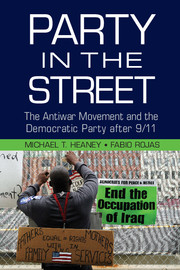Book contents
- Frontmatter
- Dedication
- Contents
- List of Tables
- List of Figures
- List of Abbreviations
- Introduction
- 1 The Party in the Street and Its Historical Context
- 2 Partisan Politics at the Water's Edge?
- 3 Multiple Identities and Party-Movement Interaction
- 4 Identities and Grassroots Participation
- 5 Identities and Organizational Action
- 6 Identities and Legislative Agendas
- 7 Beyond the Antiwar Movement and the Democratic Party
- 8 Social Movements in a Polarized America
- Epilogue
- Appendixes
- References
- Index
1 - The Party in the Street and Its Historical Context
Published online by Cambridge University Press: 05 February 2015
- Frontmatter
- Dedication
- Contents
- List of Tables
- List of Figures
- List of Abbreviations
- Introduction
- 1 The Party in the Street and Its Historical Context
- 2 Partisan Politics at the Water's Edge?
- 3 Multiple Identities and Party-Movement Interaction
- 4 Identities and Grassroots Participation
- 5 Identities and Organizational Action
- 6 Identities and Legislative Agendas
- 7 Beyond the Antiwar Movement and the Democratic Party
- 8 Social Movements in a Polarized America
- Epilogue
- Appendixes
- References
- Index
Summary
The Republican Party held its quadrennial presidential nominating convention at Madison Square Garden in New York City from August 30 to September 2, 2004. The selection of New York City was a highly symbolic choice. Less than three years earlier, 2,763 people had been killed in New York as a result of coordinated terrorist attacks on September 11, 2001. In siting its convention in New York, the Republican National Committee sought to demonstrate its solidarity with 9/11 victims. The Republicans also hoped to bolster the reelection prospects of their nominee, President George W. Bush, by framing his policies – such as the USA PATRIOT Act, the Homeland Security Act, the invasion of Afghanistan, and the invasion of Iraq – as effective responses to the events of 9/11.
The decision to hold the 2004 Republican National Convention (RNC) in New York was contentious, especially given the liberal leanings of New York's population. It should have come as little surprise to Republicans that their convention was met by massive protests from the general public. For more than a week, New York City was besieged by demonstrations large and small, organized on issues ranging from women's rights to the Iraq War to the human needs of people living in poverty.
- Type
- Chapter
- Information
- Party in the StreetThe Antiwar Movement and the Democratic Party after 9/11, pp. 14 - 45Publisher: Cambridge University PressPrint publication year: 2015



